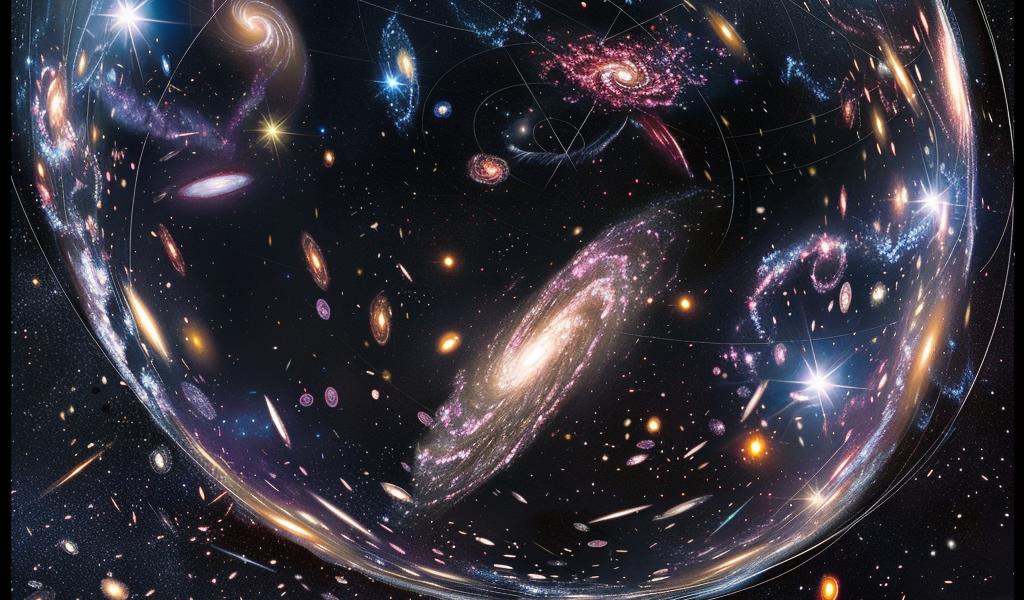A mesmerizing phenomenon in the cosmos, known as a gravitational lens, has caught the attention of astronomers, providing a unique glimpse into the depths of space. This cosmic optical illusion functions like a magnifying glass, allowing scientists to observe distant galaxies and quasars in ways that were previously unimaginable.
Recently, the Hubble Space Telescope (HST) captured stunning images of a gravitational lens referred to as “The Carousel Lens.” This extraordinary lens showcases a rare alignment of seven background galaxies, all of which appear distorted due to the presence of an intervening galaxy cluster. The image, released by astronomers, highlights the intricate dance of celestial bodies and the complex gravitational interactions at play.
David Schlegel, a senior scientist at Berkeley Lab, expressed excitement about this discovery, emphasizing its significance in the field of astronomy. He remarked, “This is an amazingly lucky ‘galactic line-up’—a chance alignment of multiple galaxies across a line-of-sight spanning most of the observable Universe. Finding one such alignment is a needle in the haystack. Finding all of these is like eight needles precisely lined up inside that haystack.” This statement underscores the rarity and importance of such gravitational lensing events.
The Carousel Lens was initially identified in data from the Dark Energy Survey a few years ago. Astronomers are now focusing their efforts on measuring its mass and studying the effects it has on the images of more distant galaxies. This gravitational lens, consisting of seven galaxies and a foreground galaxy cluster, has the potential to unlock new insights into the early Universe and contribute to our understanding of cosmology.
To understand the mechanics of the Carousel Lens, it’s essential to grasp the concept of large-scale gravitational lenses. These lenses typically consist of a “lensing object”—in this case, a galaxy cluster—and more distant objects behind it, which are usually galaxies and quasars. On a smaller scale, gravitational lenses can occur when a planet passes in front of its star, creating a similar effect.
The Carousel Lens is particularly notable for its cosmic scale, with the lensing cluster located approximately 5 billion light-years away from Earth. This cluster, designated as DESI-090.9854-35.9683, contains at least four large galaxy members and several other possible cluster constituents. The seven distant galaxies that the Carousel Lens distorts are located between 7.62 and 12 billion light-years from our planet.
The gravitational lensing phenomenon results in multiple images of each of these more distant galaxies, creating a striking visual effect reminiscent of a funhouse mirror. One of the galaxies, labeled “4a, 4b, 4c, 4d,” forms a nearly perfect “Einstein Cross,” a configuration that illustrates the symmetrical distribution of mass within the lensing cluster.
According to Xiaoshang Huang, a member of the Berkeley team studying the Carousel Lens, this discovery exemplifies the characteristics of a “strong lens” in the Universe. The team has been diligently searching for such cosmic alignments, and the Carousel Lens serves as a prime example of their efforts.
The implications of studying the Carousel Lens extend beyond mere curiosity; they provide valuable insights into the formation and evolution of galaxies. By analyzing the mass of the lensing cluster and the properties of the background galaxies, astronomers can glean information about the early Universe and the processes that shaped it.
This research is not only significant for our understanding of the cosmos but also for the ongoing quest to unravel the mysteries of dark energy and dark matter. The gravitational lensing effect can help scientists map the distribution of these elusive components, which play a crucial role in the Universe’s expansion and structure.
As astronomers continue to explore the Carousel Lens and other gravitational lenses, they are hopeful that these cosmic phenomena will provide answers to some of the most profound questions in modern astrophysics. The study of gravitational lenses is a rapidly evolving field, and each new discovery brings with it the potential to reshape our understanding of the Universe.
In summary, the Carousel Lens stands as a testament to the wonders of the Universe and the remarkable capabilities of modern astronomy. As researchers delve deeper into the intricacies of gravitational lensing, they are poised to uncover new knowledge that could illuminate the path of cosmic evolution and the fundamental forces that govern our existence.





